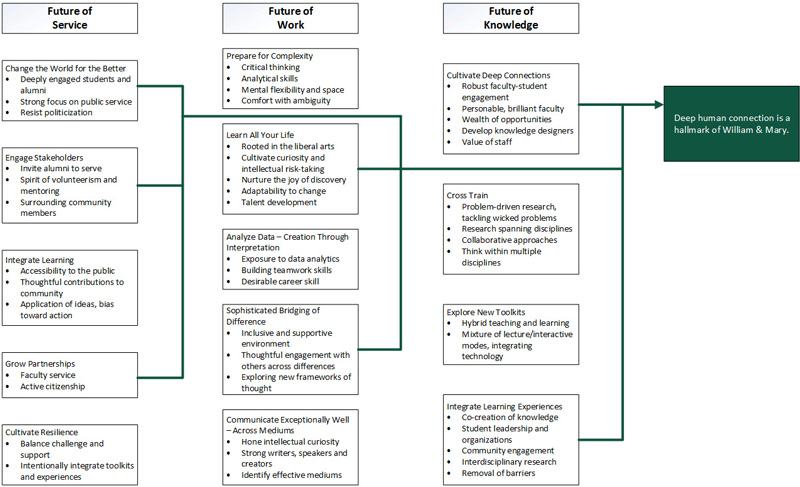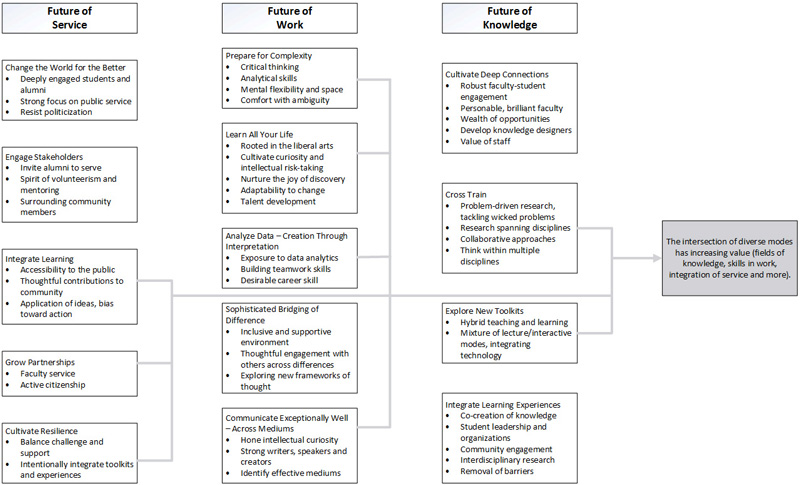About Thinking Forward
On Charter Day, William & Mary will celebrate its 326th birthday. At the same time, I'll be inaugurated as the university's 28th president and Robert Gates '65, L.H.D. '98, will be re-invested as chancellor. During the ceremony, students will continue the lovely tradition of reading aloud from our royal charter.
The charter calls for William & Mary "to be supported and maintained, in all time coming." I read these words to you nearly one year ago, when the Board of Visitors announced my election as president, delighting in and sobered by their ambition. I have kept them at front of mind since, while engaging William & Mary's community in thoughtful and generative conversations about our future.
This essay reflects on the work we accomplished together over the past six months: how we convened a community-wide conversation, how we gathered shared insights and how we then played back those insights for further refinement. Throughout the spring, we will move into a period of pre-planning, to prepare for more formal strategic planning in the fall. The final section of this essay lists some of the areas of study and early exploration – generated during the Thinking Forward conversations – that will direct our immediate next steps.
Fall Listening: Convening a Community-Wide Conversation Around Mission
 At the start of the fall semester, as a way of getting to know William & Mary swiftly and deeply, I announced Thinking Forward, a series of sustained community conversations that ranged from large listening sessions on campus to comments online. Our discussions focused on the future of three of William & Mary's core mission areas – knowledge, work and service – providing strategic focus for conversation and also creating space for reflection and aspiration.
At the start of the fall semester, as a way of getting to know William & Mary swiftly and deeply, I announced Thinking Forward, a series of sustained community conversations that ranged from large listening sessions on campus to comments online. Our discussions focused on the future of three of William & Mary's core mission areas – knowledge, work and service – providing strategic focus for conversation and also creating space for reflection and aspiration.
The future of knowledge
William & Mary convenes the brightest minds to advance knowledge for the common good. When I asked faculty what was changing in their fields, as they pursue this mission, I was stunned by their answer. Multiple scholars, across disciplines of the arts and humanities, social sciences and sciences, replied: "Everything." In such a rapidly evolving landscape of learning, William & Mary should set the global standard for liberal arts and sciences blended with professional education and advanced research.
The future of work
We heard similar insights from alumni and staff about the pace of change in their workplaces. The latest statistics from the Institute for the Future (pdf) find that 85 percent of the jobs that today's students will do in 2030 have not been created yet. How will we prepare graduates to lean into workplace changes brought about by new technology, such as AI? How might we partner with alumni who are charting new paths through those changes? And as a place of employment for more than 2,000 people, how does William & Mary foster entrepreneurial thinking and support lifelong learning – embracing those same changes when they enhance our success at work? A Facilities staff member shared this profound insight: "When you harbor old ideas, you harbor old ways." How might we cultivate new ideas and new ways in this community of learning and practice?
The future of service
William & Mary has often been called the Alma Mater of a nation. How will we prepare future generations for service to community, the commonwealth, nation and world? Chancellor Gates is a powerful example of our tradition in service, and there are countless others, including the more than 3,500 students who participate in service projects annually – locally and across the globe.
Winter Playback: Gathering and Reflecting Back Community Insights
This past semester, I heard from every cohort in the diverse and far-flung William & Mary community. Our conversations produced more than 800 comments, reflections and suggestions. These arrived in paper form: from scribbled notes and stickies to long and graceful letters. They flew in through the ether via tweets and Instagram messages, emails and online submissions. Our small research team coded each comment according to the core themes it expressed – and as we read, new themes emerged. By tabulating how often different themes appeared, we were able to see which ideas were convergent and which were divergent.
We then played back three overarching themes at our fourth Listening Session, a Playback Session to invite refinement and feedback, which we have now incorporated here.
William & Mary cultivates deep human connections.
"As an undergrad, the most important experiences revolve around brilliant faculty who want to engage with us…" – Student, Listening Forum
We know from research that a strong intellectual connection with a faculty member is the key success factor for learning and the top predictor of student success in every profession. And we deliver on this powerfully. Remarkably, 85 percent of William & Mary's undergraduate students conduct research with a faculty mentor. These intellectually rich relationships are a significant area of strength university-wide: how might we build on them to welcome in new participants and partners, from across the university and beyond?
The intersection of diverse modes of thinking and work has increasing value in every field and profession.
"…Future knowledge breakthroughs will require multidisciplinary thinking." – Alumna/us, Web Submission
As a lifelong athlete, I recognize the power of cross-training at a moment when professions and disciplines are changing so rapidly. Here again, William & Mary starts from a position of strength. Undergraduate students pursue double majors at among the highest rates of any university in the United States, including the Ivy League. Our new College Curriculum stresses breadth of method across all four years. At the graduate level, students apply computational methods, like data visualization and Twitter and web scraping, to their own research in the humanities and social sciences.
In William & Mary's professional schools and in graduate and undergraduate Arts & Sciences, how might we more intentionally cultivate such multimodal thinking? How might we ensure that our graduates grow their creative and reflective capacities; practice collaborative and solo work; adopt both quantitative and qualitative approaches to problem-solving; integrate technical savvy with emotional intelligence?
Sophistication in bridging difference, cultivated in an inclusive community, enriches our lives – in the advancement of knowledge, in the workplace, in service and, most importantly, in relationships with others.
"...Teach/train/encourage discussion around difference so that we can explore unknown frameworks and listen/know each other more clearly." – Commenter, Listening Forum
Diversity accelerates innovation and fosters community when it is welcomed as a strength. Students, faculty and staff increasingly bring varied experiences and skills to William & Mary. How might we embrace these differences in support of our mission? As a community, we have begun courageous conversations through the Diversity & Inclusion Symposium and student dialogues. How might we facilitate these discussions in a full and sustained way? How might we partner student, faculty and staff knowledge and experiences to support learning and research? How might we best support the needs of a diverse community?
Spring Pre-Planning: Preparing for Strategic Planning
William & Mary has a long tradition of innovating to advance the values we cherish most and to sustain our mission in challenging times. The many complex questions revealed through your comments are a testament to the robustness of our conversations.
This semester, we'll engage in disciplined exploration of the questions you raised in Thinking Forward and begin moving forward on key initiatives as we prepare to launch formal strategic planning in August 2019. One mechanism for moving forward will be tiger teams,which will allow the university to explore substantive, high-impact ideas that could simultaneously advance academic excellence and our financial stability. Our community is proving highly entrepreneurial, and tiger teams will provide the venue for disciplined development of concepts toward a decision point.
Some of the questions we will begin to explore, in advance of formal strategic planning, include:
- For the university, what aspects of our learning environment are most supportive of fostering deep human connections?
- How can technology enhance our mission and improve our work?
- How might we break down silos in research, learning and work, to increase generative collaboration?
- How could we increase our comfort with ambiguity – a key to navigating gracefully the rapid pace of change in our classrooms, labs, studios, playing fields and workplaces?
- Who is a learner? When and where will learning happen and what will accelerate effective learning in the future?
The excitement and ambition of these conversations has been palpable, as is the open-ness with which the William & Mary community has embraced the opportunity to listen to each other. I am grateful to have such thoughtful partners in my work, as we seek to create a future worthy of our historic past.
Katherine A. Rowe
President


















